Module 2 Care for Babies and Toddlers Assignment - Diploma
VerifiedAdded on 2022/10/04
|16
|2958
|18
Homework Assignment
AI Summary
This document presents a completed assignment for the Diploma of Early Childhood Education and Care, focusing on Module 2: Care for Babies and Toddlers. The assignment addresses key aspects of early childhood education, including the National Quality Standard, EYLF elements, and daily routines. It delves into children's health and safety, providing cues for recognizing physical states and appropriate responses. The assignment also covers essential topics such as breastfeeding, infant formula preparation, and the introduction of solid foods. It includes guidelines for safe food handling, oral health, and infection control, alongside strategies for creating safe environments. Furthermore, it explores family preferences, developmental stages, and the four stages of attachment, providing a comprehensive overview of caring for babies and toddlers. This assignment offers a detailed exploration of various aspects related to caring for infants and toddlers.
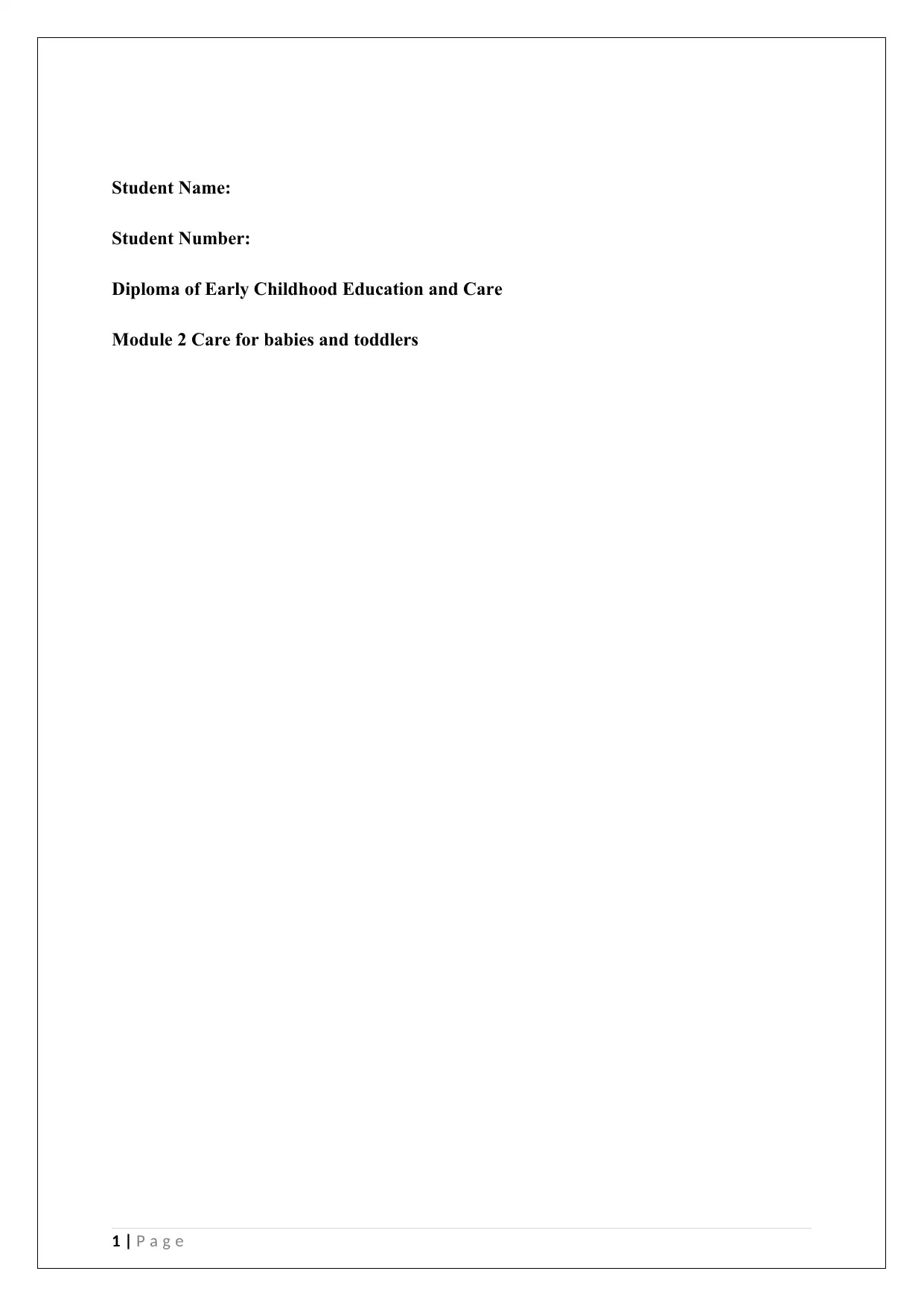
Student Name:
Student Number:
Diploma of Early Childhood Education and Care
Module 2 Care for babies and toddlers
1 | P a g e
Student Number:
Diploma of Early Childhood Education and Care
Module 2 Care for babies and toddlers
1 | P a g e
Paraphrase This Document
Need a fresh take? Get an instant paraphrase of this document with our AI Paraphraser
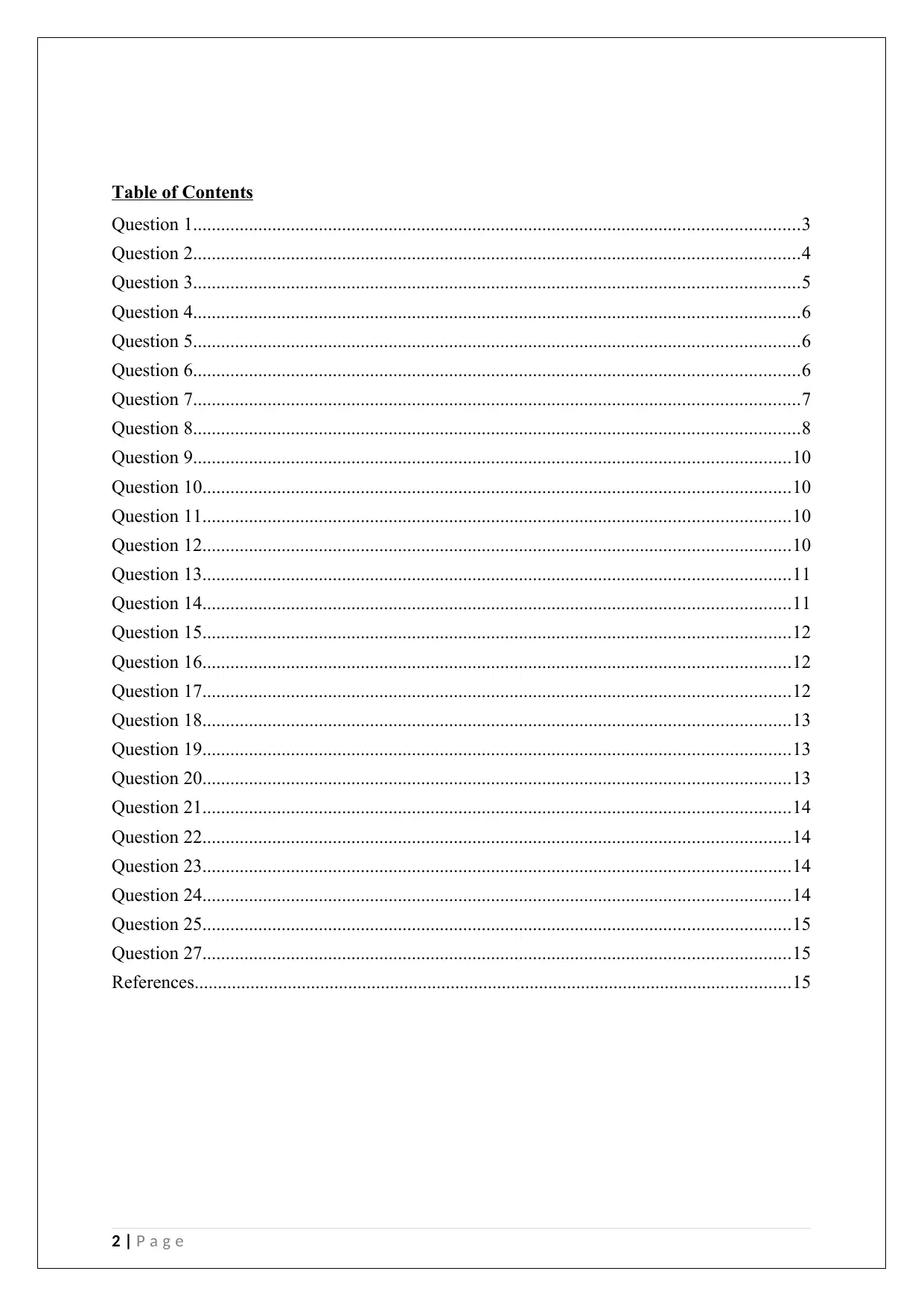
Table of Contents
Question 1..................................................................................................................................3
Question 2..................................................................................................................................4
Question 3..................................................................................................................................5
Question 4..................................................................................................................................6
Question 5..................................................................................................................................6
Question 6..................................................................................................................................6
Question 7..................................................................................................................................7
Question 8..................................................................................................................................8
Question 9................................................................................................................................10
Question 10..............................................................................................................................10
Question 11..............................................................................................................................10
Question 12..............................................................................................................................10
Question 13..............................................................................................................................11
Question 14..............................................................................................................................11
Question 15..............................................................................................................................12
Question 16..............................................................................................................................12
Question 17..............................................................................................................................12
Question 18..............................................................................................................................13
Question 19..............................................................................................................................13
Question 20..............................................................................................................................13
Question 21..............................................................................................................................14
Question 22..............................................................................................................................14
Question 23..............................................................................................................................14
Question 24..............................................................................................................................14
Question 25..............................................................................................................................15
Question 27..............................................................................................................................15
References................................................................................................................................15
2 | P a g e
Question 1..................................................................................................................................3
Question 2..................................................................................................................................4
Question 3..................................................................................................................................5
Question 4..................................................................................................................................6
Question 5..................................................................................................................................6
Question 6..................................................................................................................................6
Question 7..................................................................................................................................7
Question 8..................................................................................................................................8
Question 9................................................................................................................................10
Question 10..............................................................................................................................10
Question 11..............................................................................................................................10
Question 12..............................................................................................................................10
Question 13..............................................................................................................................11
Question 14..............................................................................................................................11
Question 15..............................................................................................................................12
Question 16..............................................................................................................................12
Question 17..............................................................................................................................12
Question 18..............................................................................................................................13
Question 19..............................................................................................................................13
Question 20..............................................................................................................................13
Question 21..............................................................................................................................14
Question 22..............................................................................................................................14
Question 23..............................................................................................................................14
Question 24..............................................................................................................................14
Question 25..............................................................................................................................15
Question 27..............................................................................................................................15
References................................................................................................................................15
2 | P a g e
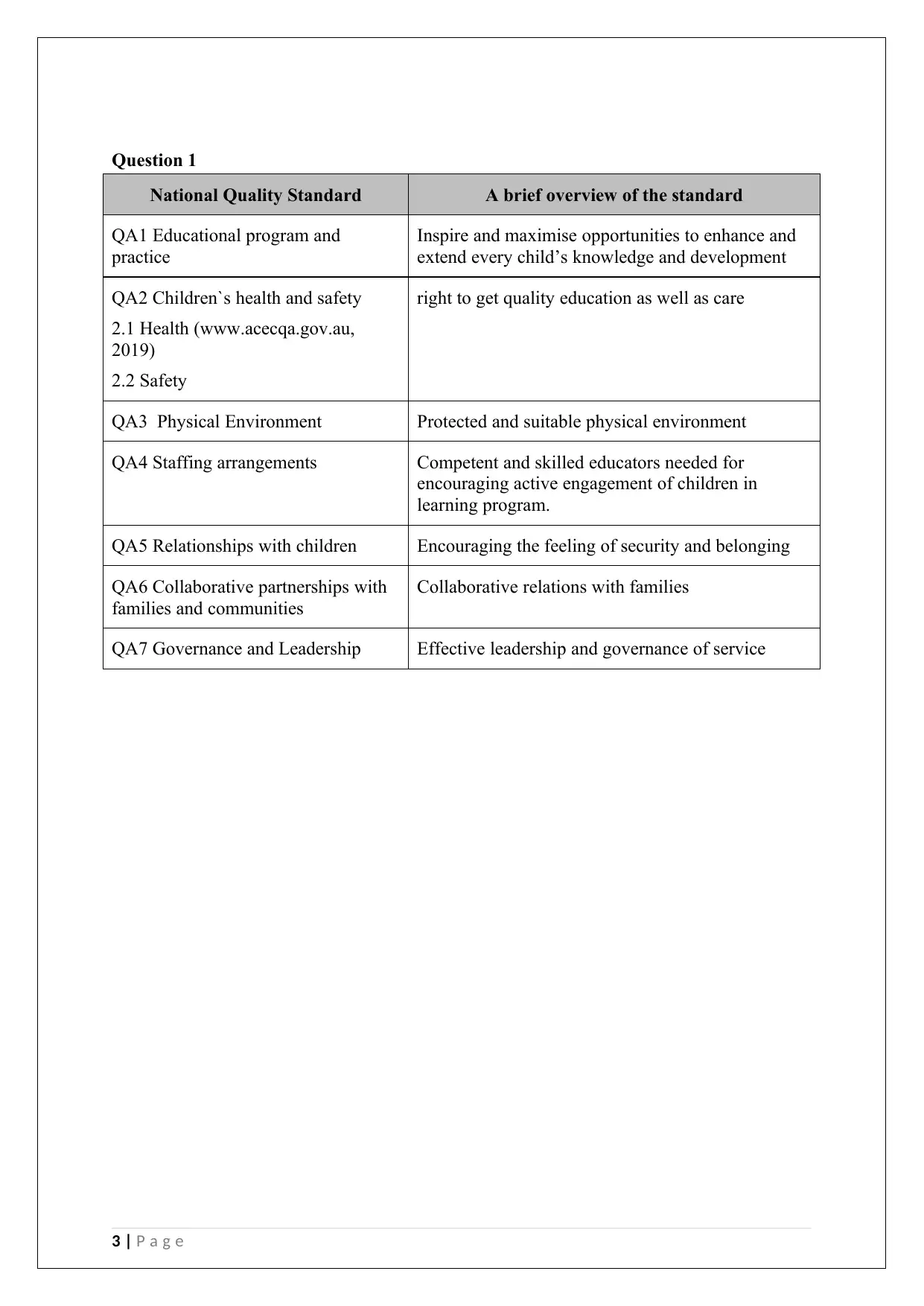
Question 1
National Quality Standard A brief overview of the standard
QA1 Educational program and
practice
Inspire and maximise opportunities to enhance and
extend every child’s knowledge and development
QA2 Children`s health and safety
2.1 Health (www.acecqa.gov.au,
2019)
2.2 Safety
right to get quality education as well as care
QA3 Physical Environment Protected and suitable physical environment
QA4 Staffing arrangements Competent and skilled educators needed for
encouraging active engagement of children in
learning program.
QA5 Relationships with children Encouraging the feeling of security and belonging
QA6 Collaborative partnerships with
families and communities
Collaborative relations with families
QA7 Governance and Leadership Effective leadership and governance of service
3 | P a g e
National Quality Standard A brief overview of the standard
QA1 Educational program and
practice
Inspire and maximise opportunities to enhance and
extend every child’s knowledge and development
QA2 Children`s health and safety
2.1 Health (www.acecqa.gov.au,
2019)
2.2 Safety
right to get quality education as well as care
QA3 Physical Environment Protected and suitable physical environment
QA4 Staffing arrangements Competent and skilled educators needed for
encouraging active engagement of children in
learning program.
QA5 Relationships with children Encouraging the feeling of security and belonging
QA6 Collaborative partnerships with
families and communities
Collaborative relations with families
QA7 Governance and Leadership Effective leadership and governance of service
3 | P a g e
⊘ This is a preview!⊘
Do you want full access?
Subscribe today to unlock all pages.

Trusted by 1+ million students worldwide
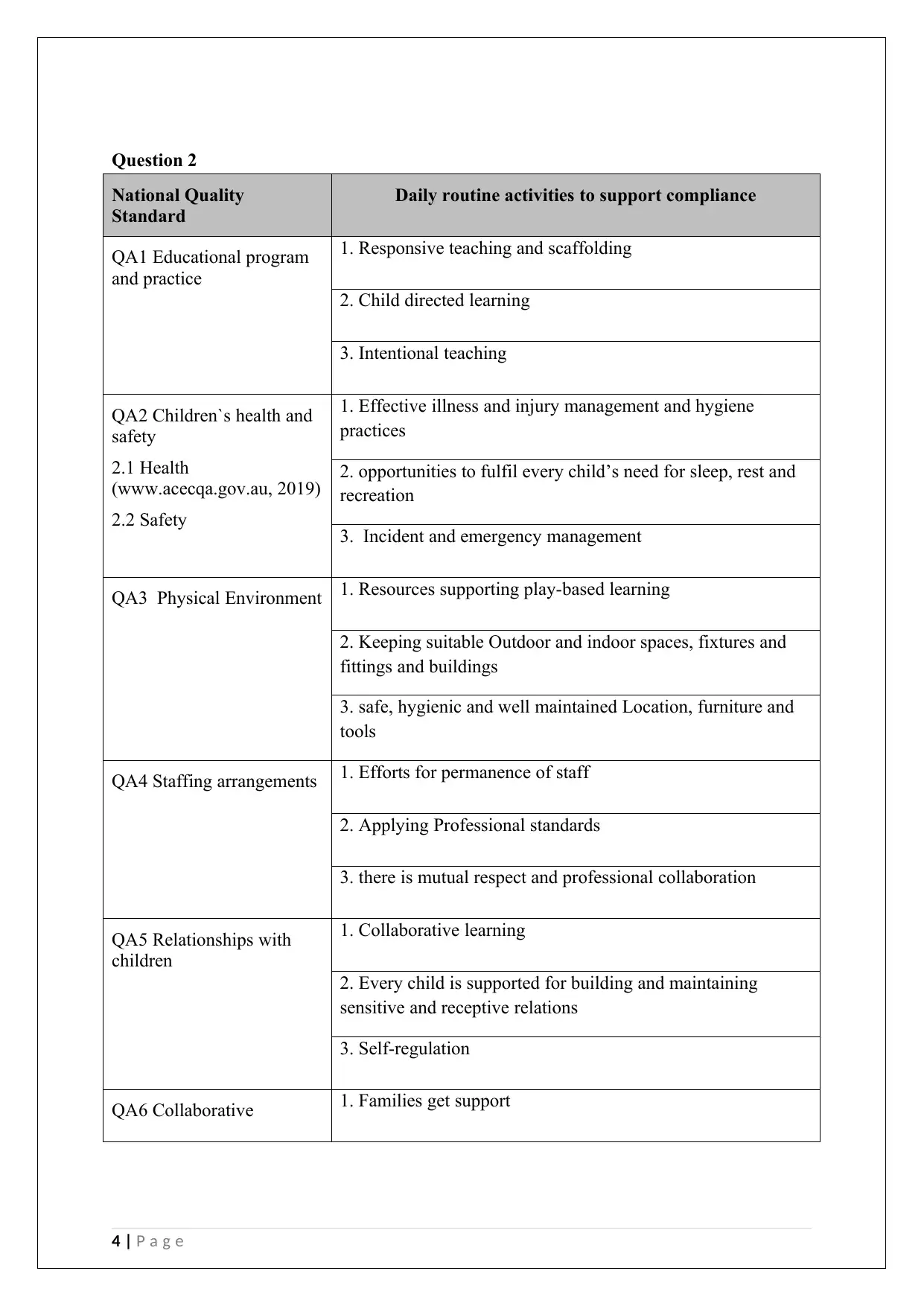
Question 2
National Quality
Standard
Daily routine activities to support compliance
QA1 Educational program
and practice
1. Responsive teaching and scaffolding
2. Child directed learning
3. Intentional teaching
QA2 Children`s health and
safety
2.1 Health
(www.acecqa.gov.au, 2019)
2.2 Safety
1. Effective illness and injury management and hygiene
practices
2. opportunities to fulfil every child’s need for sleep, rest and
recreation
3. Incident and emergency management
QA3 Physical Environment 1. Resources supporting play-based learning
2. Keeping suitable Outdoor and indoor spaces, fixtures and
fittings and buildings
3. safe, hygienic and well maintained Location, furniture and
tools
QA4 Staffing arrangements 1. Efforts for permanence of staff
2. Applying Professional standards
3. there is mutual respect and professional collaboration
QA5 Relationships with
children
1. Collaborative learning
2. Every child is supported for building and maintaining
sensitive and receptive relations
3. Self-regulation
QA6 Collaborative 1. Families get support
4 | P a g e
National Quality
Standard
Daily routine activities to support compliance
QA1 Educational program
and practice
1. Responsive teaching and scaffolding
2. Child directed learning
3. Intentional teaching
QA2 Children`s health and
safety
2.1 Health
(www.acecqa.gov.au, 2019)
2.2 Safety
1. Effective illness and injury management and hygiene
practices
2. opportunities to fulfil every child’s need for sleep, rest and
recreation
3. Incident and emergency management
QA3 Physical Environment 1. Resources supporting play-based learning
2. Keeping suitable Outdoor and indoor spaces, fixtures and
fittings and buildings
3. safe, hygienic and well maintained Location, furniture and
tools
QA4 Staffing arrangements 1. Efforts for permanence of staff
2. Applying Professional standards
3. there is mutual respect and professional collaboration
QA5 Relationships with
children
1. Collaborative learning
2. Every child is supported for building and maintaining
sensitive and receptive relations
3. Self-regulation
QA6 Collaborative 1. Families get support
4 | P a g e
Paraphrase This Document
Need a fresh take? Get an instant paraphrase of this document with our AI Paraphraser
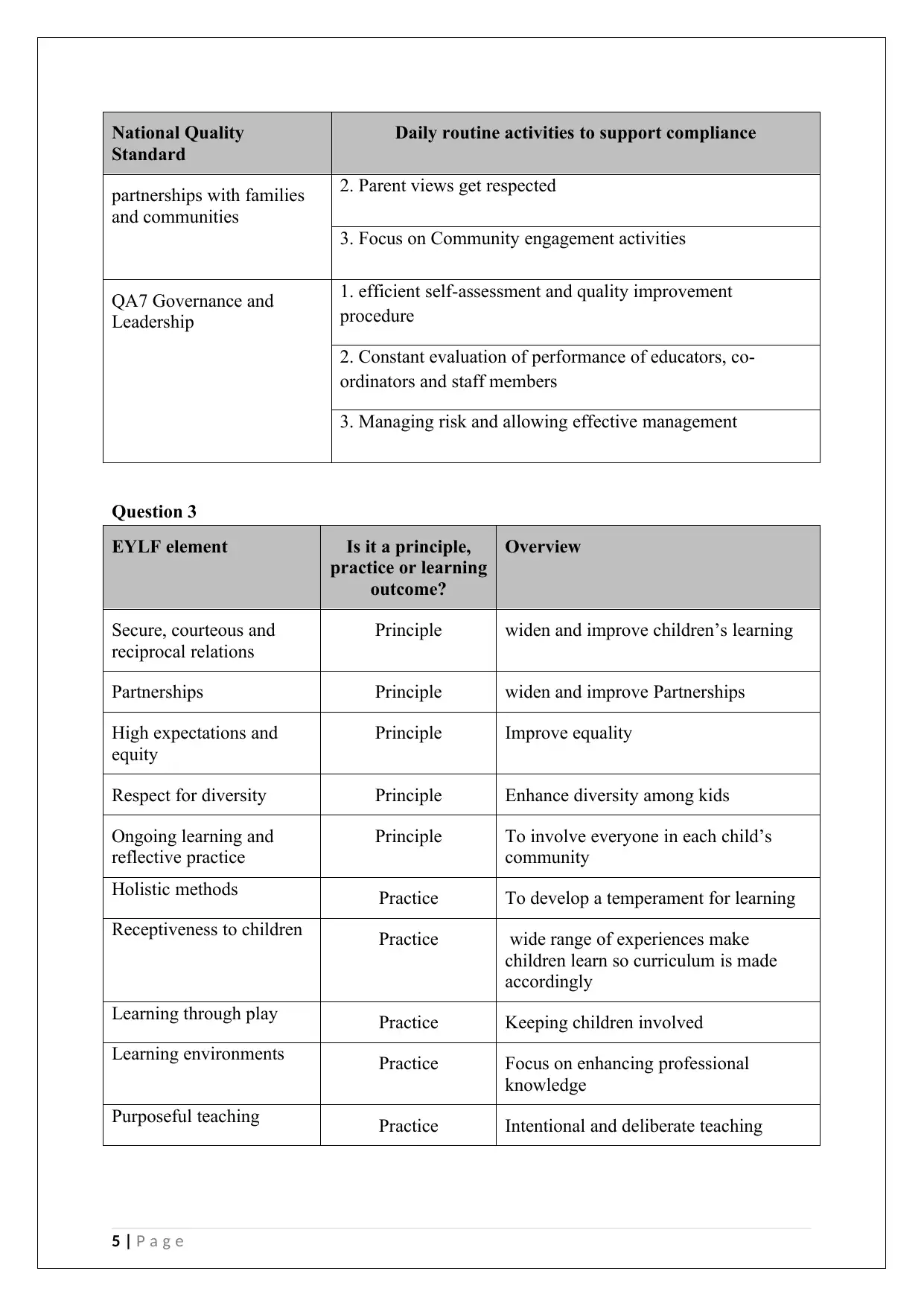
National Quality
Standard
Daily routine activities to support compliance
partnerships with families
and communities
2. Parent views get respected
3. Focus on Community engagement activities
QA7 Governance and
Leadership
1. efficient self-assessment and quality improvement
procedure
2. Constant evaluation of performance of educators, co-
ordinators and staff members
3. Managing risk and allowing effective management
Question 3
EYLF element Is it a principle,
practice or learning
outcome?
Overview
Secure, courteous and
reciprocal relations
Principle widen and improve children’s learning
Partnerships Principle widen and improve Partnerships
High expectations and
equity
Principle Improve equality
Respect for diversity Principle Enhance diversity among kids
Ongoing learning and
reflective practice
Principle To involve everyone in each child’s
community
Holistic methods Practice To develop a temperament for learning
Receptiveness to children Practice wide range of experiences make
children learn so curriculum is made
accordingly
Learning through play Practice Keeping children involved
Learning environments Practice Focus on enhancing professional
knowledge
Purposeful teaching Practice Intentional and deliberate teaching
5 | P a g e
Standard
Daily routine activities to support compliance
partnerships with families
and communities
2. Parent views get respected
3. Focus on Community engagement activities
QA7 Governance and
Leadership
1. efficient self-assessment and quality improvement
procedure
2. Constant evaluation of performance of educators, co-
ordinators and staff members
3. Managing risk and allowing effective management
Question 3
EYLF element Is it a principle,
practice or learning
outcome?
Overview
Secure, courteous and
reciprocal relations
Principle widen and improve children’s learning
Partnerships Principle widen and improve Partnerships
High expectations and
equity
Principle Improve equality
Respect for diversity Principle Enhance diversity among kids
Ongoing learning and
reflective practice
Principle To involve everyone in each child’s
community
Holistic methods Practice To develop a temperament for learning
Receptiveness to children Practice wide range of experiences make
children learn so curriculum is made
accordingly
Learning through play Practice Keeping children involved
Learning environments Practice Focus on enhancing professional
knowledge
Purposeful teaching Practice Intentional and deliberate teaching
5 | P a g e
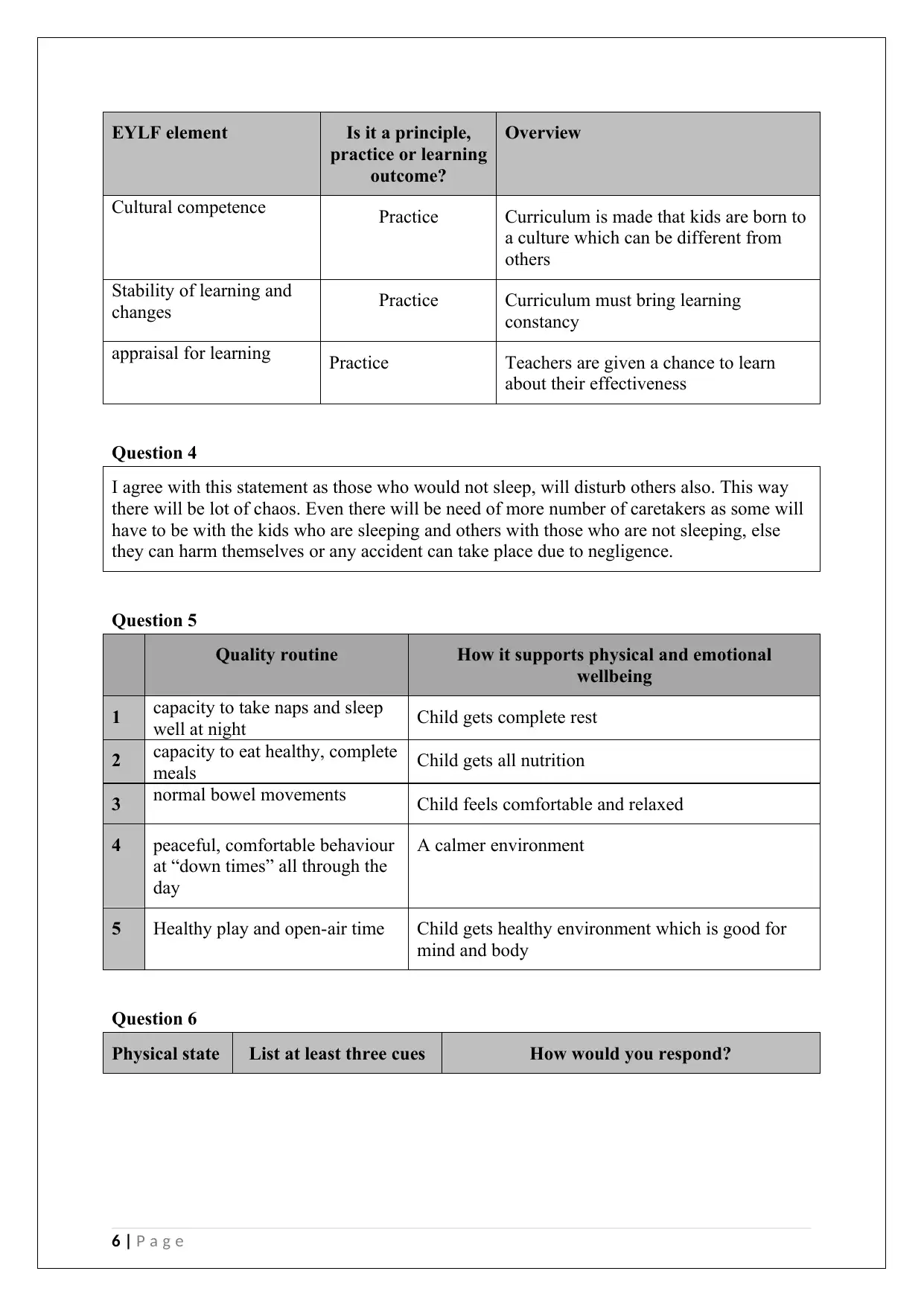
EYLF element Is it a principle,
practice or learning
outcome?
Overview
Cultural competence Practice Curriculum is made that kids are born to
a culture which can be different from
others
Stability of learning and
changes Practice Curriculum must bring learning
constancy
appraisal for learning Practice Teachers are given a chance to learn
about their effectiveness
Question 4
I agree with this statement as those who would not sleep, will disturb others also. This way
there will be lot of chaos. Even there will be need of more number of caretakers as some will
have to be with the kids who are sleeping and others with those who are not sleeping, else
they can harm themselves or any accident can take place due to negligence.
Question 5
Quality routine How it supports physical and emotional
wellbeing
1 capacity to take naps and sleep
well at night Child gets complete rest
2 capacity to eat healthy, complete
meals Child gets all nutrition
3 normal bowel movements Child feels comfortable and relaxed
4 peaceful, comfortable behaviour
at “down times” all through the
day
A calmer environment
5 Healthy play and open-air time Child gets healthy environment which is good for
mind and body
Question 6
Physical state List at least three cues How would you respond?
6 | P a g e
practice or learning
outcome?
Overview
Cultural competence Practice Curriculum is made that kids are born to
a culture which can be different from
others
Stability of learning and
changes Practice Curriculum must bring learning
constancy
appraisal for learning Practice Teachers are given a chance to learn
about their effectiveness
Question 4
I agree with this statement as those who would not sleep, will disturb others also. This way
there will be lot of chaos. Even there will be need of more number of caretakers as some will
have to be with the kids who are sleeping and others with those who are not sleeping, else
they can harm themselves or any accident can take place due to negligence.
Question 5
Quality routine How it supports physical and emotional
wellbeing
1 capacity to take naps and sleep
well at night Child gets complete rest
2 capacity to eat healthy, complete
meals Child gets all nutrition
3 normal bowel movements Child feels comfortable and relaxed
4 peaceful, comfortable behaviour
at “down times” all through the
day
A calmer environment
5 Healthy play and open-air time Child gets healthy environment which is good for
mind and body
Question 6
Physical state List at least three cues How would you respond?
6 | P a g e
⊘ This is a preview!⊘
Do you want full access?
Subscribe today to unlock all pages.

Trusted by 1+ million students worldwide
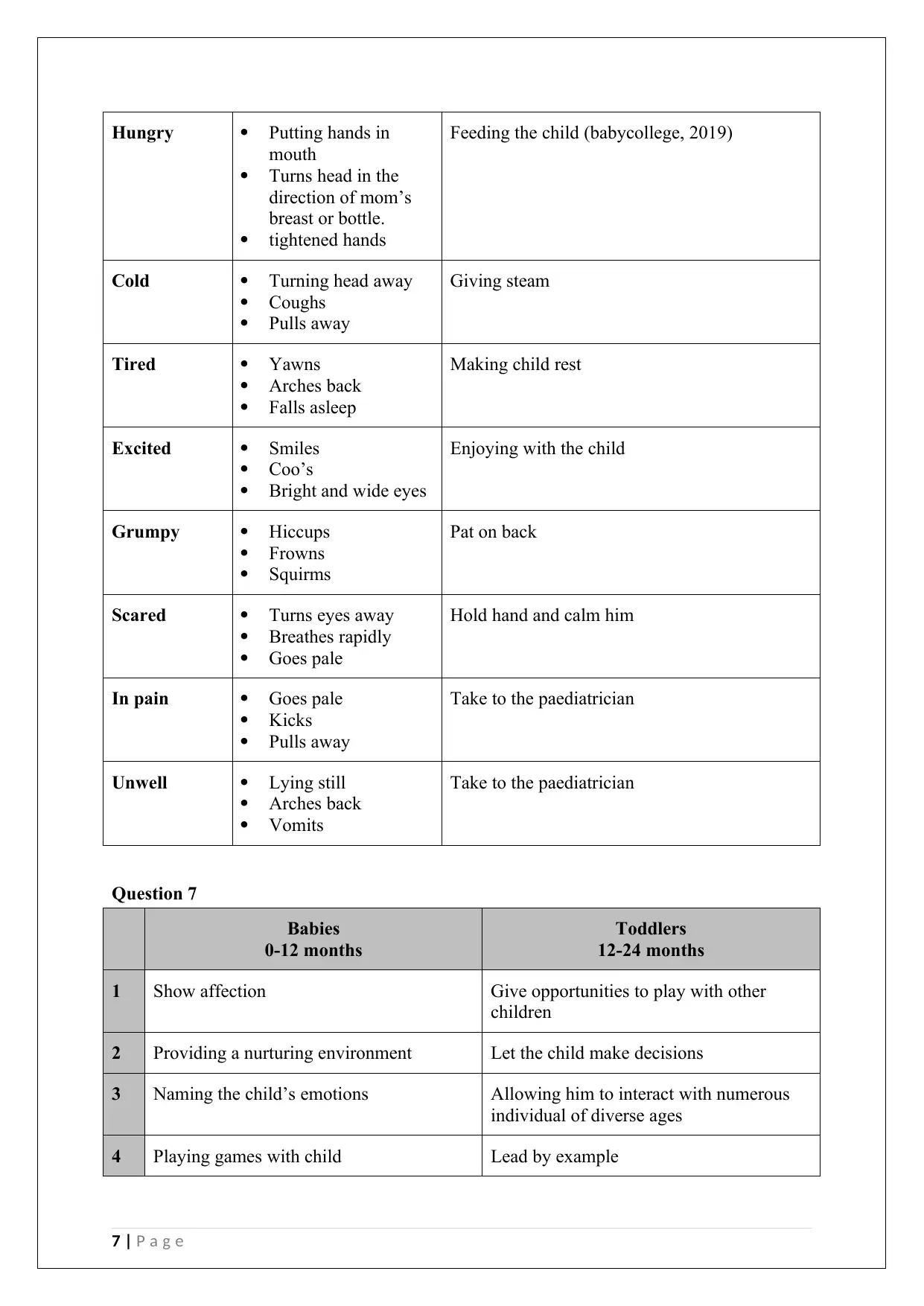
Hungry Putting hands in
mouth
Turns head in the
direction of mom’s
breast or bottle.
tightened hands
Feeding the child (babycollege, 2019)
Cold Turning head away
Coughs
Pulls away
Giving steam
Tired Yawns
Arches back
Falls asleep
Making child rest
Excited Smiles
Coo’s
Bright and wide eyes
Enjoying with the child
Grumpy Hiccups
Frowns
Squirms
Pat on back
Scared Turns eyes away
Breathes rapidly
Goes pale
Hold hand and calm him
In pain Goes pale
Kicks
Pulls away
Take to the paediatrician
Unwell Lying still
Arches back
Vomits
Take to the paediatrician
Question 7
Babies
0-12 months
Toddlers
12-24 months
1 Show affection Give opportunities to play with other
children
2 Providing a nurturing environment Let the child make decisions
3 Naming the child’s emotions Allowing him to interact with numerous
individual of diverse ages
4 Playing games with child Lead by example
7 | P a g e
mouth
Turns head in the
direction of mom’s
breast or bottle.
tightened hands
Feeding the child (babycollege, 2019)
Cold Turning head away
Coughs
Pulls away
Giving steam
Tired Yawns
Arches back
Falls asleep
Making child rest
Excited Smiles
Coo’s
Bright and wide eyes
Enjoying with the child
Grumpy Hiccups
Frowns
Squirms
Pat on back
Scared Turns eyes away
Breathes rapidly
Goes pale
Hold hand and calm him
In pain Goes pale
Kicks
Pulls away
Take to the paediatrician
Unwell Lying still
Arches back
Vomits
Take to the paediatrician
Question 7
Babies
0-12 months
Toddlers
12-24 months
1 Show affection Give opportunities to play with other
children
2 Providing a nurturing environment Let the child make decisions
3 Naming the child’s emotions Allowing him to interact with numerous
individual of diverse ages
4 Playing games with child Lead by example
7 | P a g e
Paraphrase This Document
Need a fresh take? Get an instant paraphrase of this document with our AI Paraphraser
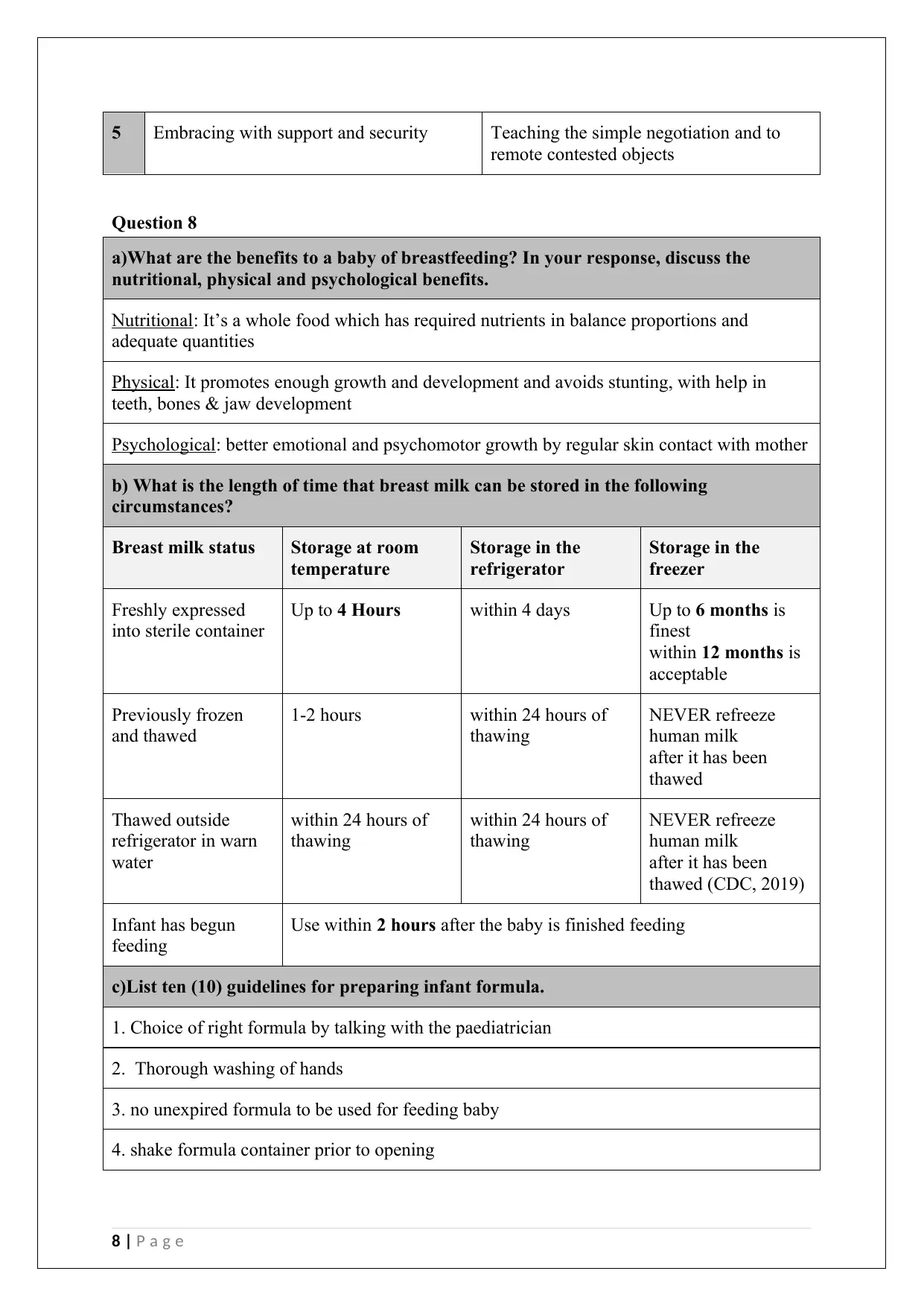
5 Embracing with support and security Teaching the simple negotiation and to
remote contested objects
Question 8
a)What are the benefits to a baby of breastfeeding? In your response, discuss the
nutritional, physical and psychological benefits.
Nutritional: It’s a whole food which has required nutrients in balance proportions and
adequate quantities
Physical: It promotes enough growth and development and avoids stunting, with help in
teeth, bones & jaw development
Psychological: better emotional and psychomotor growth by regular skin contact with mother
b) What is the length of time that breast milk can be stored in the following
circumstances?
Breast milk status Storage at room
temperature
Storage in the
refrigerator
Storage in the
freezer
Freshly expressed
into sterile container
Up to 4 Hours within 4 days Up to 6 months is
finest
within 12 months is
acceptable
Previously frozen
and thawed
1-2 hours within 24 hours of
thawing
NEVER refreeze
human milk
after it has been
thawed
Thawed outside
refrigerator in warn
water
within 24 hours of
thawing
within 24 hours of
thawing
NEVER refreeze
human milk
after it has been
thawed (CDC, 2019)
Infant has begun
feeding
Use within 2 hours after the baby is finished feeding
c)List ten (10) guidelines for preparing infant formula.
1. Choice of right formula by talking with the paediatrician
2. Thorough washing of hands
3. no unexpired formula to be used for feeding baby
4. shake formula container prior to opening
8 | P a g e
remote contested objects
Question 8
a)What are the benefits to a baby of breastfeeding? In your response, discuss the
nutritional, physical and psychological benefits.
Nutritional: It’s a whole food which has required nutrients in balance proportions and
adequate quantities
Physical: It promotes enough growth and development and avoids stunting, with help in
teeth, bones & jaw development
Psychological: better emotional and psychomotor growth by regular skin contact with mother
b) What is the length of time that breast milk can be stored in the following
circumstances?
Breast milk status Storage at room
temperature
Storage in the
refrigerator
Storage in the
freezer
Freshly expressed
into sterile container
Up to 4 Hours within 4 days Up to 6 months is
finest
within 12 months is
acceptable
Previously frozen
and thawed
1-2 hours within 24 hours of
thawing
NEVER refreeze
human milk
after it has been
thawed
Thawed outside
refrigerator in warn
water
within 24 hours of
thawing
within 24 hours of
thawing
NEVER refreeze
human milk
after it has been
thawed (CDC, 2019)
Infant has begun
feeding
Use within 2 hours after the baby is finished feeding
c)List ten (10) guidelines for preparing infant formula.
1. Choice of right formula by talking with the paediatrician
2. Thorough washing of hands
3. no unexpired formula to be used for feeding baby
4. shake formula container prior to opening
8 | P a g e
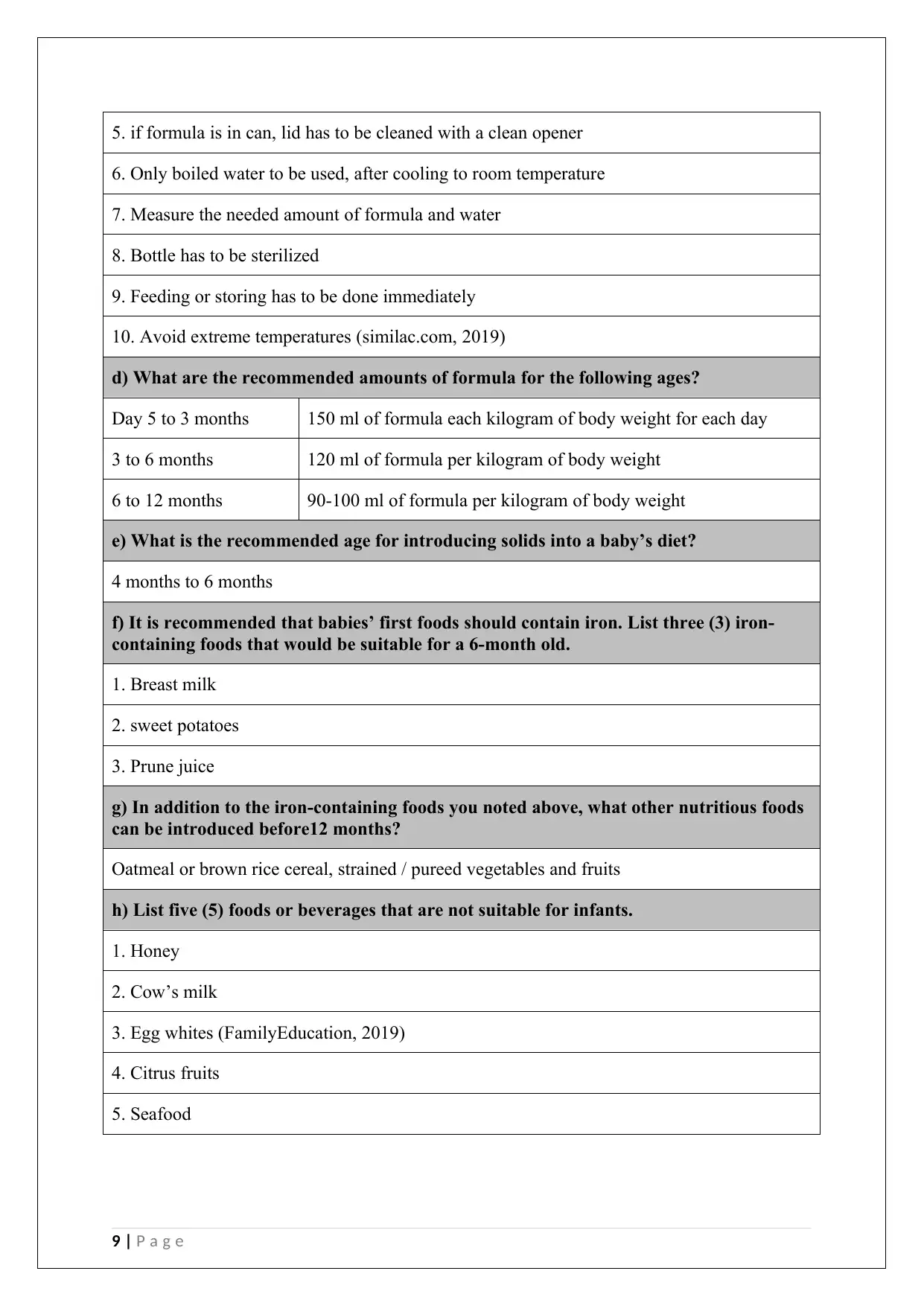
5. if formula is in can, lid has to be cleaned with a clean opener
6. Only boiled water to be used, after cooling to room temperature
7. Measure the needed amount of formula and water
8. Bottle has to be sterilized
9. Feeding or storing has to be done immediately
10. Avoid extreme temperatures (similac.com, 2019)
d) What are the recommended amounts of formula for the following ages?
Day 5 to 3 months 150 ml of formula each kilogram of body weight for each day
3 to 6 months 120 ml of formula per kilogram of body weight
6 to 12 months 90-100 ml of formula per kilogram of body weight
e) What is the recommended age for introducing solids into a baby’s diet?
4 months to 6 months
f) It is recommended that babies’ first foods should contain iron. List three (3) iron-
containing foods that would be suitable for a 6-month old.
1. Breast milk
2. sweet potatoes
3. Prune juice
g) In addition to the iron-containing foods you noted above, what other nutritious foods
can be introduced before12 months?
Oatmeal or brown rice cereal, strained / pureed vegetables and fruits
h) List five (5) foods or beverages that are not suitable for infants.
1. Honey
2. Cow’s milk
3. Egg whites (FamilyEducation, 2019)
4. Citrus fruits
5. Seafood
9 | P a g e
6. Only boiled water to be used, after cooling to room temperature
7. Measure the needed amount of formula and water
8. Bottle has to be sterilized
9. Feeding or storing has to be done immediately
10. Avoid extreme temperatures (similac.com, 2019)
d) What are the recommended amounts of formula for the following ages?
Day 5 to 3 months 150 ml of formula each kilogram of body weight for each day
3 to 6 months 120 ml of formula per kilogram of body weight
6 to 12 months 90-100 ml of formula per kilogram of body weight
e) What is the recommended age for introducing solids into a baby’s diet?
4 months to 6 months
f) It is recommended that babies’ first foods should contain iron. List three (3) iron-
containing foods that would be suitable for a 6-month old.
1. Breast milk
2. sweet potatoes
3. Prune juice
g) In addition to the iron-containing foods you noted above, what other nutritious foods
can be introduced before12 months?
Oatmeal or brown rice cereal, strained / pureed vegetables and fruits
h) List five (5) foods or beverages that are not suitable for infants.
1. Honey
2. Cow’s milk
3. Egg whites (FamilyEducation, 2019)
4. Citrus fruits
5. Seafood
9 | P a g e
⊘ This is a preview!⊘
Do you want full access?
Subscribe today to unlock all pages.

Trusted by 1+ million students worldwide
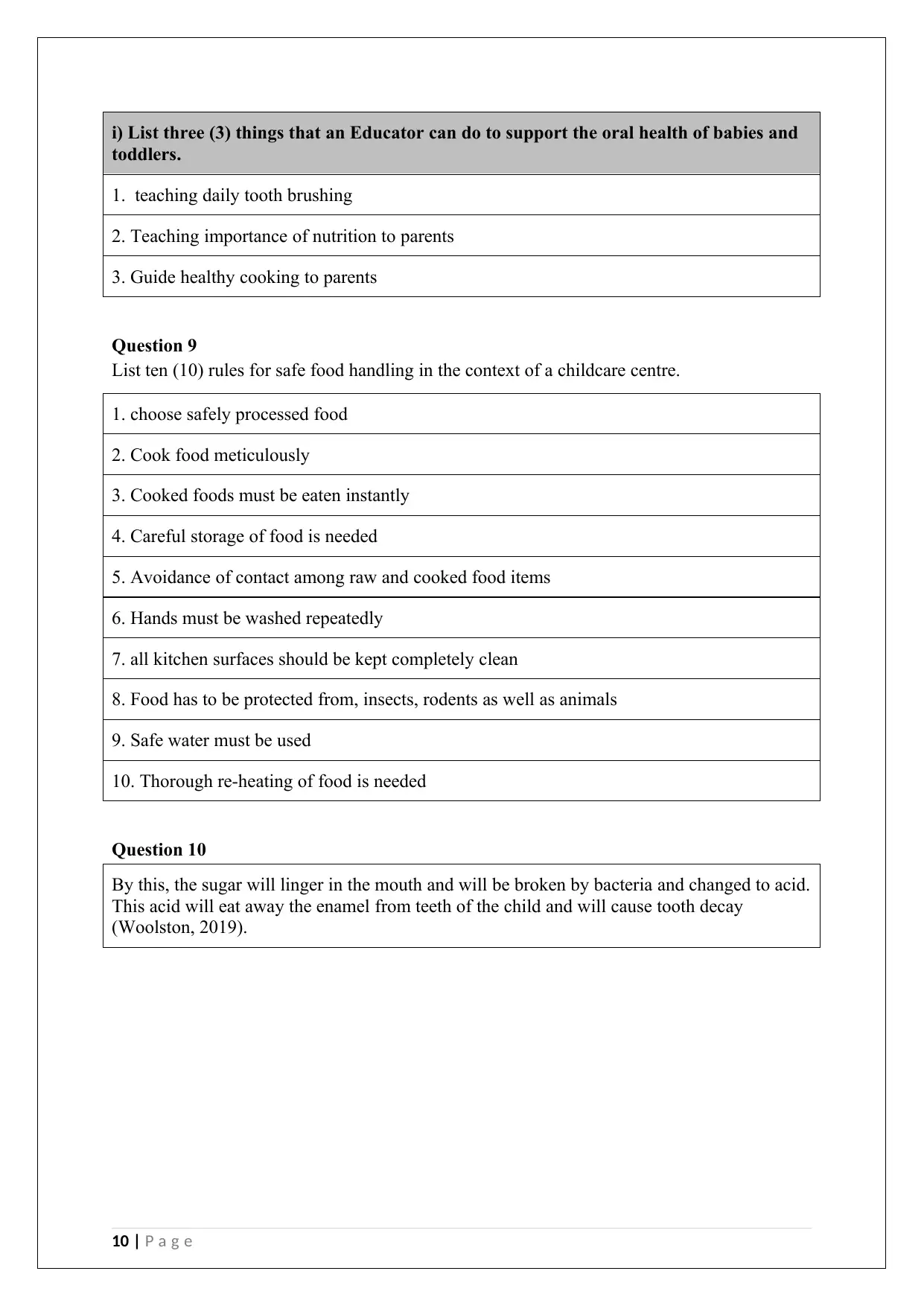
i) List three (3) things that an Educator can do to support the oral health of babies and
toddlers.
1. teaching daily tooth brushing
2. Teaching importance of nutrition to parents
3. Guide healthy cooking to parents
Question 9
List ten (10) rules for safe food handling in the context of a childcare centre.
1. choose safely processed food
2. Cook food meticulously
3. Cooked foods must be eaten instantly
4. Careful storage of food is needed
5. Avoidance of contact among raw and cooked food items
6. Hands must be washed repeatedly
7. all kitchen surfaces should be kept completely clean
8. Food has to be protected from, insects, rodents as well as animals
9. Safe water must be used
10. Thorough re-heating of food is needed
Question 10
By this, the sugar will linger in the mouth and will be broken by bacteria and changed to acid.
This acid will eat away the enamel from teeth of the child and will cause tooth decay
(Woolston, 2019).
10 | P a g e
toddlers.
1. teaching daily tooth brushing
2. Teaching importance of nutrition to parents
3. Guide healthy cooking to parents
Question 9
List ten (10) rules for safe food handling in the context of a childcare centre.
1. choose safely processed food
2. Cook food meticulously
3. Cooked foods must be eaten instantly
4. Careful storage of food is needed
5. Avoidance of contact among raw and cooked food items
6. Hands must be washed repeatedly
7. all kitchen surfaces should be kept completely clean
8. Food has to be protected from, insects, rodents as well as animals
9. Safe water must be used
10. Thorough re-heating of food is needed
Question 10
By this, the sugar will linger in the mouth and will be broken by bacteria and changed to acid.
This acid will eat away the enamel from teeth of the child and will cause tooth decay
(Woolston, 2019).
10 | P a g e
Paraphrase This Document
Need a fresh take? Get an instant paraphrase of this document with our AI Paraphraser
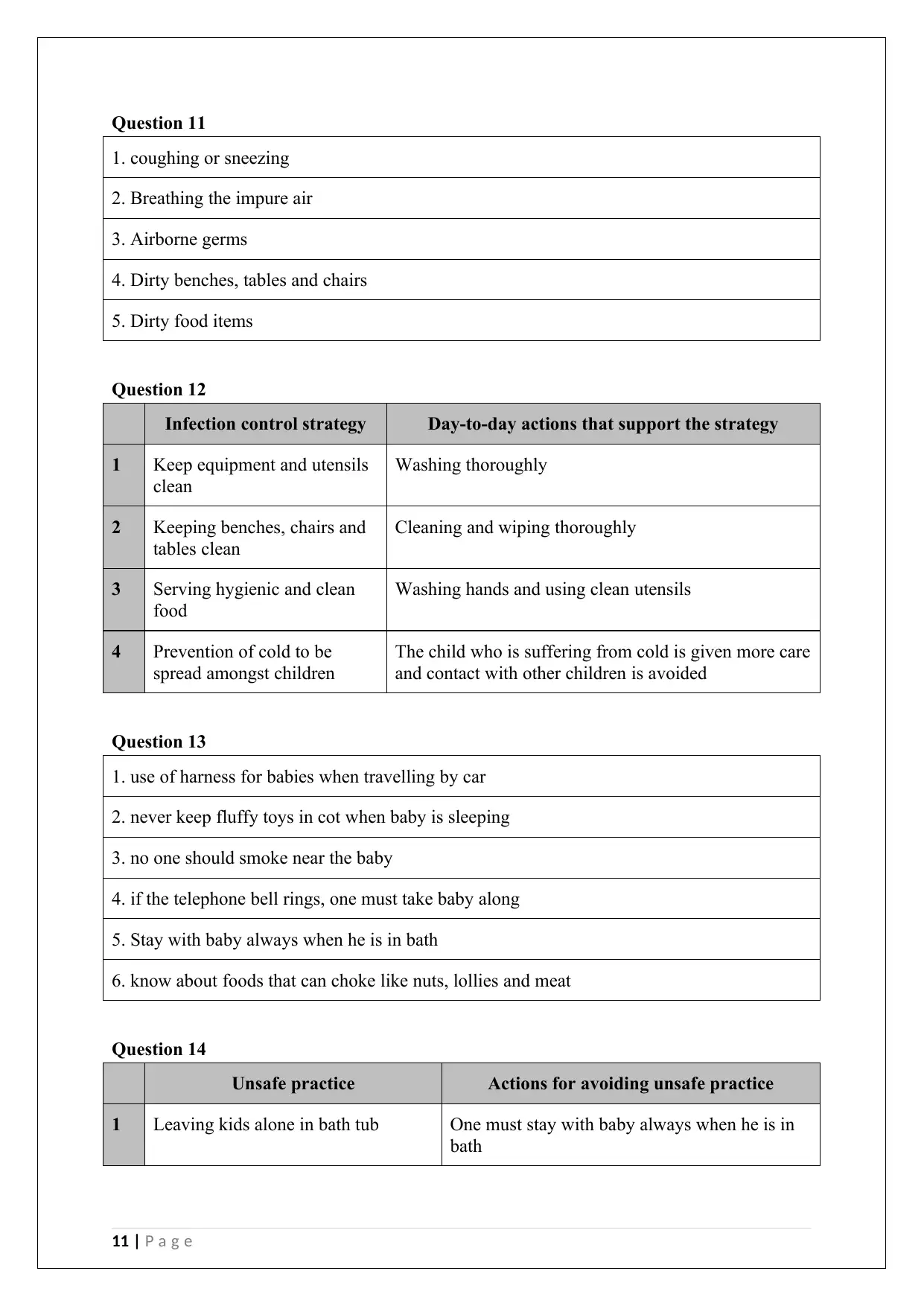
Question 11
1. coughing or sneezing
2. Breathing the impure air
3. Airborne germs
4. Dirty benches, tables and chairs
5. Dirty food items
Question 12
Infection control strategy Day-to-day actions that support the strategy
1 Keep equipment and utensils
clean
Washing thoroughly
2 Keeping benches, chairs and
tables clean
Cleaning and wiping thoroughly
3 Serving hygienic and clean
food
Washing hands and using clean utensils
4 Prevention of cold to be
spread amongst children
The child who is suffering from cold is given more care
and contact with other children is avoided
Question 13
1. use of harness for babies when travelling by car
2. never keep fluffy toys in cot when baby is sleeping
3. no one should smoke near the baby
4. if the telephone bell rings, one must take baby along
5. Stay with baby always when he is in bath
6. know about foods that can choke like nuts, lollies and meat
Question 14
Unsafe practice Actions for avoiding unsafe practice
1 Leaving kids alone in bath tub One must stay with baby always when he is in
bath
11 | P a g e
1. coughing or sneezing
2. Breathing the impure air
3. Airborne germs
4. Dirty benches, tables and chairs
5. Dirty food items
Question 12
Infection control strategy Day-to-day actions that support the strategy
1 Keep equipment and utensils
clean
Washing thoroughly
2 Keeping benches, chairs and
tables clean
Cleaning and wiping thoroughly
3 Serving hygienic and clean
food
Washing hands and using clean utensils
4 Prevention of cold to be
spread amongst children
The child who is suffering from cold is given more care
and contact with other children is avoided
Question 13
1. use of harness for babies when travelling by car
2. never keep fluffy toys in cot when baby is sleeping
3. no one should smoke near the baby
4. if the telephone bell rings, one must take baby along
5. Stay with baby always when he is in bath
6. know about foods that can choke like nuts, lollies and meat
Question 14
Unsafe practice Actions for avoiding unsafe practice
1 Leaving kids alone in bath tub One must stay with baby always when he is in
bath
11 | P a g e
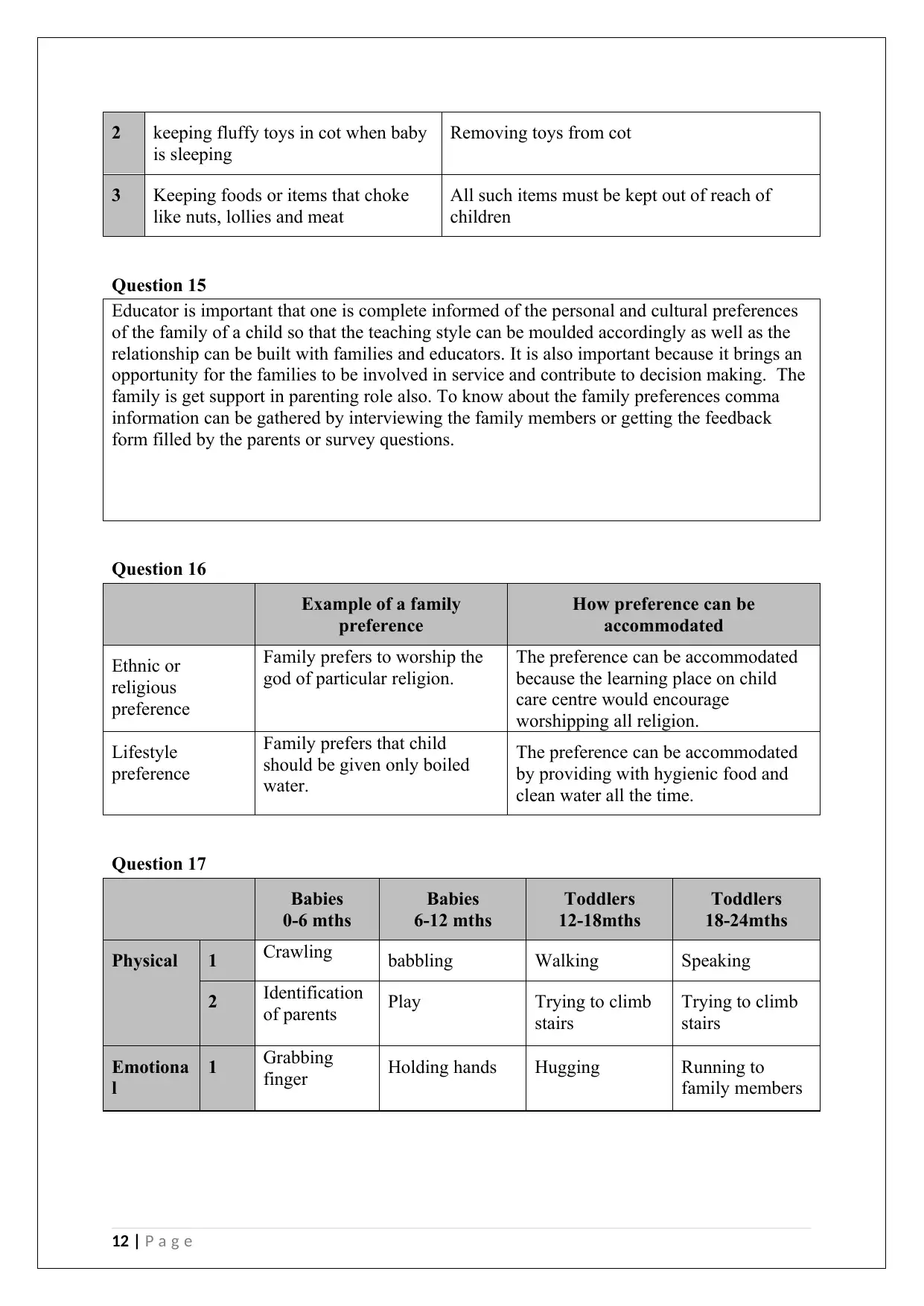
2 keeping fluffy toys in cot when baby
is sleeping
Removing toys from cot
3 Keeping foods or items that choke
like nuts, lollies and meat
All such items must be kept out of reach of
children
Question 15
Educator is important that one is complete informed of the personal and cultural preferences
of the family of a child so that the teaching style can be moulded accordingly as well as the
relationship can be built with families and educators. It is also important because it brings an
opportunity for the families to be involved in service and contribute to decision making. The
family is get support in parenting role also. To know about the family preferences comma
information can be gathered by interviewing the family members or getting the feedback
form filled by the parents or survey questions.
Question 16
Example of a family
preference
How preference can be
accommodated
Ethnic or
religious
preference
Family prefers to worship the
god of particular religion.
The preference can be accommodated
because the learning place on child
care centre would encourage
worshipping all religion.
Lifestyle
preference
Family prefers that child
should be given only boiled
water.
The preference can be accommodated
by providing with hygienic food and
clean water all the time.
Question 17
Babies
0-6 mths
Babies
6-12 mths
Toddlers
12-18mths
Toddlers
18-24mths
Physical 1 Crawling babbling Walking Speaking
2 Identification
of parents Play Trying to climb
stairs
Trying to climb
stairs
Emotiona
l
1 Grabbing
finger Holding hands Hugging Running to
family members
12 | P a g e
is sleeping
Removing toys from cot
3 Keeping foods or items that choke
like nuts, lollies and meat
All such items must be kept out of reach of
children
Question 15
Educator is important that one is complete informed of the personal and cultural preferences
of the family of a child so that the teaching style can be moulded accordingly as well as the
relationship can be built with families and educators. It is also important because it brings an
opportunity for the families to be involved in service and contribute to decision making. The
family is get support in parenting role also. To know about the family preferences comma
information can be gathered by interviewing the family members or getting the feedback
form filled by the parents or survey questions.
Question 16
Example of a family
preference
How preference can be
accommodated
Ethnic or
religious
preference
Family prefers to worship the
god of particular religion.
The preference can be accommodated
because the learning place on child
care centre would encourage
worshipping all religion.
Lifestyle
preference
Family prefers that child
should be given only boiled
water.
The preference can be accommodated
by providing with hygienic food and
clean water all the time.
Question 17
Babies
0-6 mths
Babies
6-12 mths
Toddlers
12-18mths
Toddlers
18-24mths
Physical 1 Crawling babbling Walking Speaking
2 Identification
of parents Play Trying to climb
stairs
Trying to climb
stairs
Emotiona
l
1 Grabbing
finger Holding hands Hugging Running to
family members
12 | P a g e
⊘ This is a preview!⊘
Do you want full access?
Subscribe today to unlock all pages.

Trusted by 1+ million students worldwide
1 out of 16
Related Documents
Your All-in-One AI-Powered Toolkit for Academic Success.
+13062052269
info@desklib.com
Available 24*7 on WhatsApp / Email
![[object Object]](/_next/static/media/star-bottom.7253800d.svg)
Unlock your academic potential
Copyright © 2020–2025 A2Z Services. All Rights Reserved. Developed and managed by ZUCOL.




